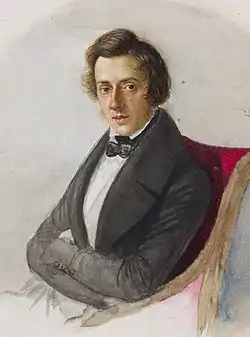Trois nouvelles études
Frédéric Chopin wrote his Trois nouvelles études ("three new studies") for piano in 1839, as a contribution to "Méthode des méthodes de piano", a piano instruction book by Ignaz Moscheles and François-Joseph Fétis.[1] They are often erroneously described as posthumous. These études are less technical than the composer's Op. 10 and 25 and retain Chopin's original formula for harmonic and structural balance.

Chopin, 1835
The Études
- The first of the Trois nouvelles études is an intimate piece in F minor. It develops students' facility with 3-on-4 polyrhythms.[1]
- The key of the second étude is A♭ major sits atop a series of chords in the right hand with a simple bass in the left hand. It develops students' facility with 2-on-3 polyrhythms.
- The third and last étude, in D♭ major, is the most technically challenging in this collection. It develops independence of voices and articulation in the right hand, with the upper melodic line quite legato over a staccato alto accompaniment. Some of the reaches required between the alto and soprano lines may be difficult for pianists with smaller hands.
References
External links
- Chopin, Trois Nouvelles Études, B. 130 Sheet music (with introductory note) at Musopen
- Trois nouvelles études: Scores at the International Music Score Library Project
- Details, Carnegie Hall Data Lab
- No. 1, No. 2, No. 3 played by Alfred Cortot on YouTube
- No. 1, No. 2, No. 3 played by Claudio Arrau on YouTube
This article is issued from Wikipedia. The text is licensed under Creative Commons - Attribution - Sharealike. Additional terms may apply for the media files.